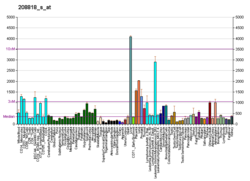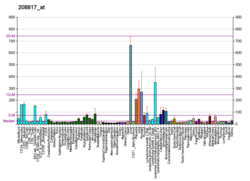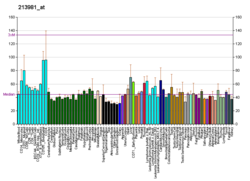| COMT |
|---|
 |
| Estruturas disponíveis |
|---|
| PDB | Pesquisa Human UniProt: PDBe RCSB |
|---|
| Lista de códigos id do PDB |
|---|
4XUE, 3A7E, 3BWM, 3BWY, 4PYI, 4PYJ, 4PYK, 4XUC, 4XUD |
|
|
| Identificadores |
|---|
| Nomes alternativos | COMT |
|---|
| IDs externos | OMIM: 116790 HomoloGene: 30982 GeneCards: COMT |
|---|
|
| Targeted by Drug |
|---|
| entacapone, tolcapona, Viroporin 3a[1] |
| Ontologia genética |
|---|
| Função molecular | • transferase activity
• O-methyltransferase activity
• metal ion binding
• GO:0001948, GO:0016582 ligação a proteínas plasmáticas
• magnesium ion binding
• catechol O-methyltransferase activity
• GO:0102674, GO:0102675 methyltransferase activity
• L-dopa O-methyltransferase activity
• orcinol O-methyltransferase activity
|
|---|
| Componente celular | • citoplasma
• integral component of membrane
• corpo celular
• citosol
• postsynaptic membrane
• membrane
• membrana plasmática
• Espinha dendrítica
• axónio
• dendrito
• mitocôndria
• Exossoma
• intracellular membrane-bounded organelle
|
|---|
| Processo biológico | • multicellular organismal reproductive process
• negative regulation of smooth muscle cell proliferation
• GO:1904578 response to organic cyclic compound
• regulation of sensory perception of pain
• estrogen metabolic process
• cellular response to phosphate starvation
• catechol-containing compound metabolic process
• female pregnancy
• negative regulation of dopamine metabolic process
• GO:0007571 developmental process
• aprendizagem
• catecholamine metabolic process
• neurotransmitter catabolic process
• response to lipopolysaccharide
• metilação
• dopamine metabolic process
• response to pain
• memória a curto prazo
• negative regulation of renal sodium excretion
• dopamine catabolic process
• positive regulation of homocysteine metabolic process
• catecholamine catabolic process
• response to estrogen
|
|---|
| Sources:Amigo / QuickGO |
|
|
| Ortólogos |
|---|
| Espécie | Humano | Rato |
|---|
| Entrez | | |
|---|
| Ensembl | | |
|---|
| UniProt | | |
|---|
| RefSeq (mRNA) | |
|---|
NM_000754
NM_001135161
NM_001135162
NM_007310
NM_001362828 |
| |
|---|
| RefSeq (proteína) | |
|---|
NP_000745
NP_001128633
NP_001128634
NP_009294
NP_001349757 |
| |
|---|
| Localização (UCSC) | n/a | n/a |
|---|
| Pesquisa PubMed | [2] | n/a |
|---|
|
| Wikidata |
|


 . PMID 17913879. doi:10.1073/pnas.0706111104
. PMID 17913879. doi:10.1073/pnas.0706111104 














